| Chemical Coordination and Integration Refresher Course |
| Chemical Coordination and Integration Concepts Files |
| Chemical Coordination and Integration Master Files |
| Chemical Coordination and Integration Revision Note |
| Chemical Coordination and Integration Note 1 |
| Chemical Coordination and Integration Reference Book |
Chemical Coordination and Integration
Table of contents
- Endocrine Glands and Hormones
- The Hypothalamus
- The Pituitary Gland
- The Pineal Gland
- Thyroid Gland
- Parathyroid Gland
- Thymus
- Adrenal Gland
- Pancreas
- Testes
- Ovary
- Hormones of Kidney, Gastrointestinal Tract and Kidney
- Mechanism of Hormone Action
Endocrine Glands and Hormones
Ductless glands are known as Endocrine Glands. Their secretions are known as Hormones. They are intercellular messengers that are produced in small amount.
Human Endocrine System
Endocrine glands are located in different parts of the human body. Different endocrine glands are pituitary, pineal, thyroid, parathyroid, thymus, adrenal and gonads. Kidney, liver, gastrointestinal tract also produces some hormones.
The Hypothalamus
It is located at the base of the forebrain. It contains a group of secretory cells known as Nuclei that produces hormones. The hormones secreted by the hypothalamus regulates the synthesis and secretion of pituitary hormones. There are two types of hormones produced by hypothalamus- the releasing hormones and the inhibiting hormones. For Example, gonadotropic releasing hormone stimulates the release of gonadotropins from the pituitary. These hormones reach the pituitary gland with the help of portal circulatory system.
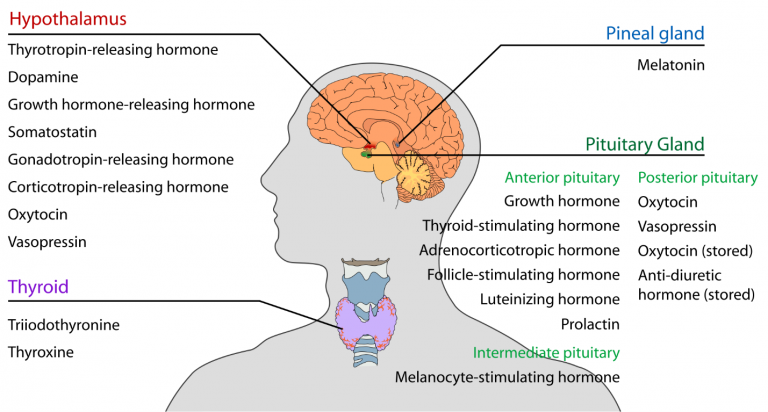
Fig. 1. Hypothalamic hormones
The Pituitary Gland
It is located in a cavity known as Sella Tursica which is attached to the hypothalamus via stalk. It is divided into adenohypophysis or anterior pituitary and neurohypophysis or posterior pituitary. Anterior pituitary produces hormones such as growth hormone, thyroid stimulating hormone, prolactin, adrenocorticotropic hormone, melanocyte stimulating hormone, follicle stimulating hormone and luteinizing hormone. Neurohypophysis releases two hormones known as Vasopressin and Oxytocin.
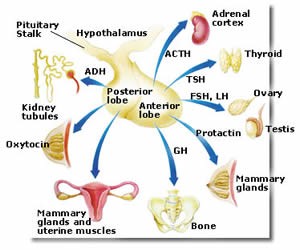
Fig. 2. Hormones secreted by pituitary glands
Growth hormone regulates general body growth such as increase in the length of the bones, controls fat, protein, and carbohydrate metabolism etc. Over secretion of growth hormone leads to gigantism whereas low secretion is associates with dwarfism.
Adrenocorticotropic hormone controls the hormones secreted by adrenal cortex.
Thyroid stimulating hormone controls the hormones secreted by thyroid glands.
Follicle stimulating hormone controls maturation of Graafian follicle in females and spermatogenesis in males.
Luteinizing hormone promotes ovulation in females and stimulates the secretion of testosterone in males.
Prolactin promotes secretion of milk from the mammary glands after child birth.
Oxytocin is a milk ejecting hormone and also functions during child birth.
Vasopressin also known as Antidiuretic Hormone (ADH) helps in reabsorption of water in the distal convoluted tubules.
The Pineal Gland
It is located on the dorsal side of the forebrain. It secretes a hormone known as melatonin. The function of melatonin is to regulate 24 hours rhythm in our body such as body temperature sleep-awake cycle etc.
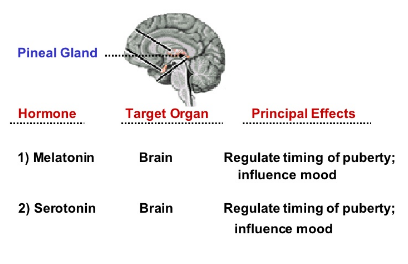
Fig. 3. Hormones secreted by pineal gland
Thyroid Gland
It consists of two lobes which are located on either side of the trachea. Both lobes are connected by a connective tissue known as Isthmus. Thyroid gland consists of follicles and stromal tissues. Thyroid follicle is composed of follicular cells that produces two hormones- tetraiodothyronine or thyroxine (T4) and triiodothyronine (T3). Iodine is an essential element for thyroid hormone synthesis.
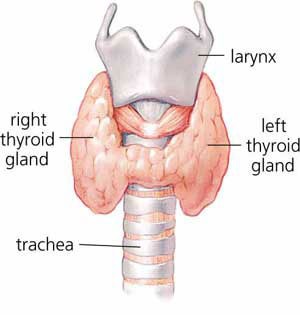
Fig. 4. Structure of thyroid gland
Deficiency of thyroid hormone causes hypothyroidism known as Goiter. Excess secretion of thyroid hormone causes hyperthyroidism. Thyroid hormones control basal metabolic rate, synthesis of red blood cells, metabolism of proteins, carbohydrates, and fats.
Parathyroid Gland
They are located at the back side of the thyroid gland and secretes a hormone known as Parathyroid Hormone or Parathormone (PTH). This hormone increases the calcium level in the blood. So, it balances the calcium level in the body.
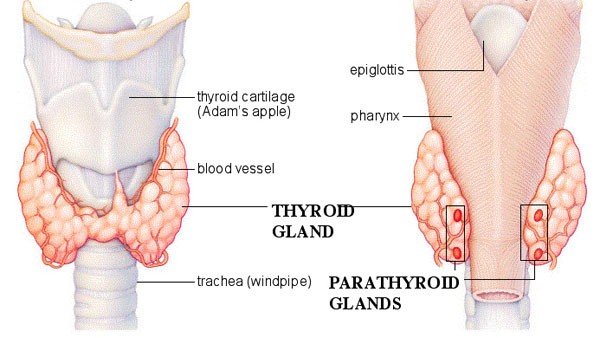
Fig. 5. Structure of parathyroid glands
Thymus
It is located between the lungs behind the sternum. It plays an important part in the development of immune system. This gland secretes a hormone known as Thymosin. It participates in cell mediated immunity. It also participates in production of antibodies.
Fig. 6. Location of thymus
Adrenal Gland
It is a pair of gland located in the anterior part of the kidney. It is composed of two types of tissues- outer adrenal cortex and inner medulla. Adrenal medulla produces two hormones known as Adrenaline and Noradrenaline. Adrenaline is also known as Emergency Hormone as it is secreted at the time of fear, fight, or flight. Adrenaline dilates the pupil increases the alertness, sweating etc.
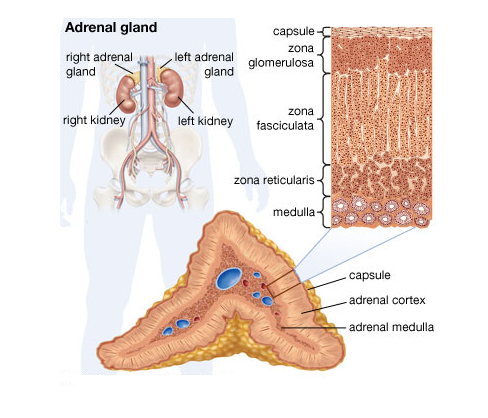
Fig. 7. Detailed structure of adrenal glands
Adrenal cortex is divided into 3 layers- Zona Reticularis (inner layer), Zona Fasciculata (middle layer) and Zona Glomerulosa (outer layer). Hormones of adrenal cortex are commonly known as corticoids. Corticoids which participate in carbohydrate metabolism are known as Glucocorticoids. They stimulate proteolysis, lipolysis, and gluconeogenesis. The main glucocorticoid is cortisol which helps in anti-inflammatory reactions and suppresses the immune system.
Corticoids that helps in water and electrolyte balance are known as mineralocorticoids. Aldosterone is the main hormone of mineralocorticoids. It helps in reabsorption of sodium ions and water and excretion of potassium and phosphate ions.
Pancreas
It is a dual gland, that is, it is endocrine as well as exocrine in function. Endocrine part of the pancreas consists of islets of Langerhans that is mainly made up of two types of cells- alpha cells and beta cells. Alpha cells secrete hormone known as Glucagon whereas beta cells secrete insulin. Glucagon maintains normal blood glucose. It increases blood glucose level. It also promotes gluconeogenesis. So, glucagon is hyperglycemic hormone.
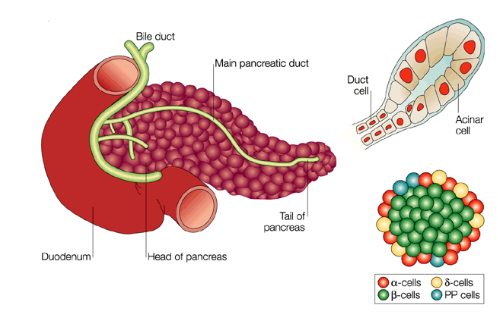
Fig. 8. Detailed structure of pancreas
Insulin also regulates glucose level in our body. It enhances cellular glucose uptake thus decreases blood glucose level. So, it is known as Hypoglycemic Hormone. Hyperglycemia causes diabetes mellitus.
Testes
They are located in scrotal sacs located outside the abdominal cavity. They are primary sex organ as well as endocrine in function. Testis is composed of seminiferous tubules and interstitial cells. Interstitial cells or Leydig cells secrete hormone known as testosterone. This hormone regulates spermatogenesis, development of beards and moustaches, as well as maturation of male accessory sex organs.
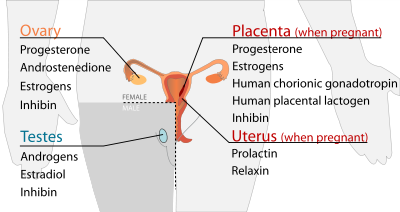
Fig. 9. Hormones secreted by ovaries and testes
Ovary
In female, a pair of ovaries are located in the abdomen. Ovary is the primary sex organ. It produces two hormones known as Estrogen and Progesterone. Estrogen helps in ovulation and during menstruation. Progesterone is a pregnancy hormone.
Hormones of Kidney, Gastrointestinal Tract and Kidney
Heart wall secretes hormone known as Atrial Natriuretic Factor (ANF) which decreases the blood pressure. Increase in the blood pressure causes release of ANF as a result blood pressure decreases.
Kidney cells secrete hormone known as Erythropoietin that promotes RBCs formation. Gastrointestinal tract secretes gastrin, secretin, cholecystokinin, and gastric inhibitory peptide.
Mechanism of Hormone Action
Hormones bind to hormone receptor to produce their effects on target tissues. Hormone receptor complex formed will leads to certain biochemical changes in the target tissue. Hormones can interact with membrane receptors as well as intracellular rectors. Steroid receptors are generally intracellular in nature whereas peptide hormones generally bind to membrane receptors.
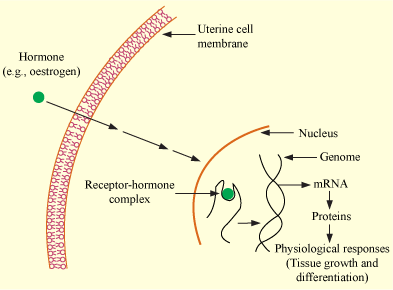
Fig. 10. Mechanism of hormone action